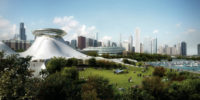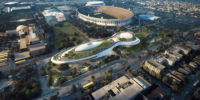Ma Yansong Unveils Design for George Lucas Museum






In a video produced by the Lucas Museum, Ma Yansong discusses his design.
View more Architectural Record videos
The building Ma has proposed, which will house the filmmaker’s private collection, resembles nothing so much as a lunar landscape. Its undulating roof culminates in a towering seven-story-high conical form, which in turn supports a cantilevered disk. That disk, containing a restaurant and a public observation deck, could be a terrestrial version of Cloud City, the gas-mining colony above the planet Bespin in The Empire Strikes Back.
In an interview this morning, Ma said that Lucas was looking for a “21st-century museum that can inspire people.” But the design is rooted not just in Lucas-ian imagery (from some angles, the squat building, with its eye-like window, could be a 400,000-square-foot Jabba the Hutt) but in other visions, including J.R.R. Tolkien's original drawing of the Lonely Mountain.
Is form following function when a building meant for artworks that tell stories—the “Narrative Art” in the name refers to everything from Norman Rockwell paintings to designs for animated films—incorporates so many images from science fact and fiction? Is this, in the Venturi lexicon, more duck than decorated shed? More Hutt than decorated hut?
Ma, who has offices in Los Angeles and Beijing, says he has been a frequent visitor to Chicago, where he once interned for Helmut Jahn, and that his goal was to have a dialogue with the city’s architectural landmarks. (It is immediately adjacent to two of them, the Miesian McCormick Place and the classically ornamented Soldier Field.) At the same time, he says, he wanted to create a building that “blends into the landscape.” The undulating roof, some parts of which will be walkable, “are meant to be an extension of the park,” he says. “This can’t be a standalone object.”
Much of the work of integrating the vast building into landscape will fall to Jeanne Gang, principal of Chicago’s Studio Gang, whom Lucas chose as landscape designer. Lucas has also selected VOA Associates Incorporated as executive architect. Michael Toolis, the Chicago-based chief executive of VOA, says that much was still to be determined about the building, which is entering the schematic design phase (and has yet to receive city approval). He says that for cladding, he is looking at composite stone.
Whatever material is chosen, the building will also be encased in irony. For years, Lucas, a California resident, wanted to locate his museum in San Francisco’s Presidio. In what many saw as an effort to gain approval there, he offered to build in a vaguely neo-classical style; the resulting design was widely derided. In June, Lucas announced that he would instead build in Chicago, and the design released today represents a stylistic 180.
According to Angelo Garcia, the President of Skywalker Properties, and Lucas’s point man on the project, “from day one, George never wanted to have a traditional building. His goal was to bring some of the best 21st-century architectural firms into a competition.”
Once the Chicago site was chosen, Lucas solicited proposals from five firms, including MAD and UN Studio. (The other three firms asked not to be named, according to Garcia.) Garcia says that when Ma presented his design, “everyone in the room”—including Lucas—“looked at each other, and said this is it.”
The building will have few windows, which Garcia says was deliberate—the goal, he explains, was to keep natural light out of the galleries. Asked whether that meant the museum would use large amounts of energy, he said it would be so well insulated that even in winter “we do not anticipate having to heat the building at all.”
Toolis says the building presented a number of technical challenges that would be addressed by working in 4-D and 5-D (he was referring to digial modeling, not sci-fi scenarios). A Chicagoan, he says the team “can’t control” how people react to Ma’s design. “There are going to be lovers and haters,” he says, “but at the end of the day we think it’s an appropriate building for Chicago.”








